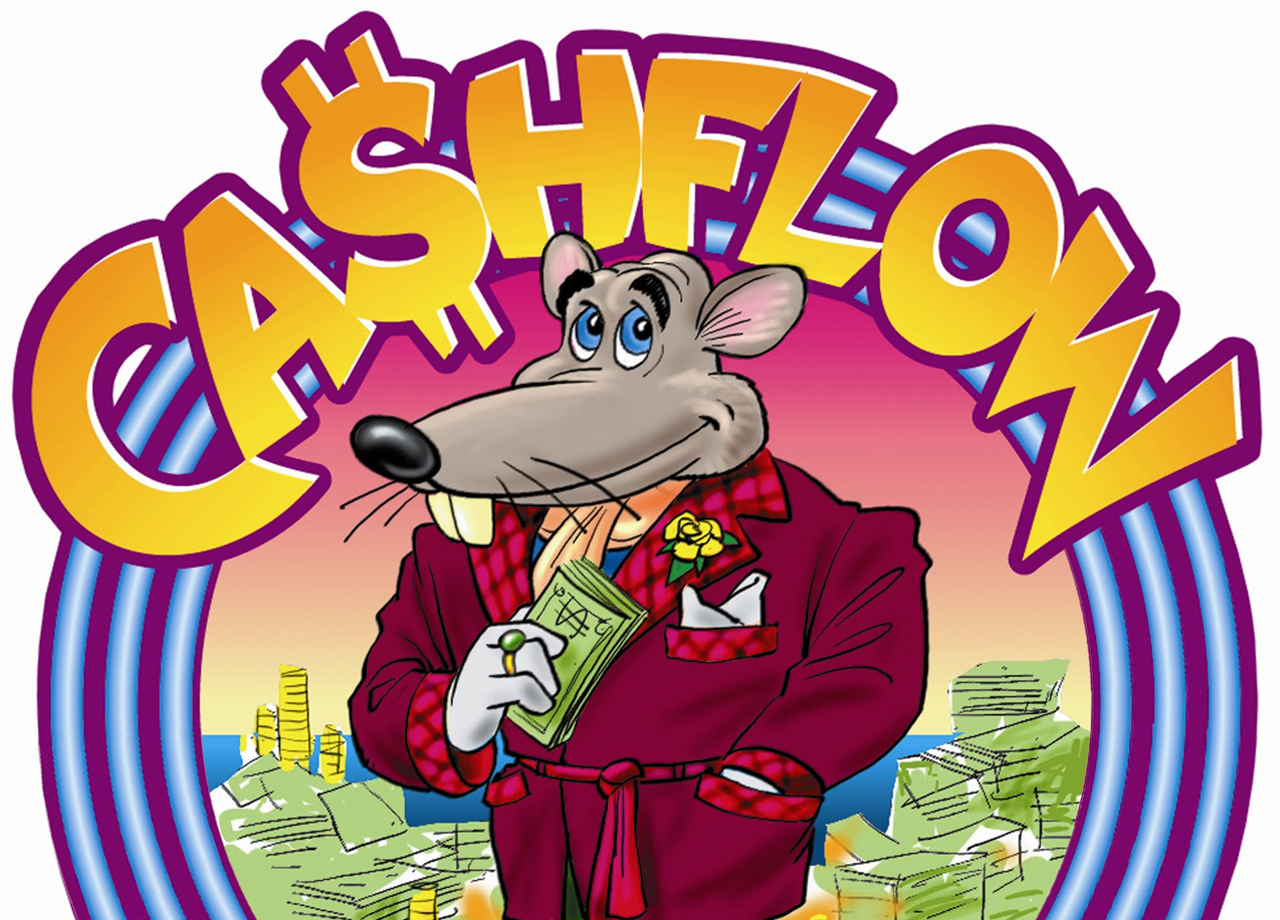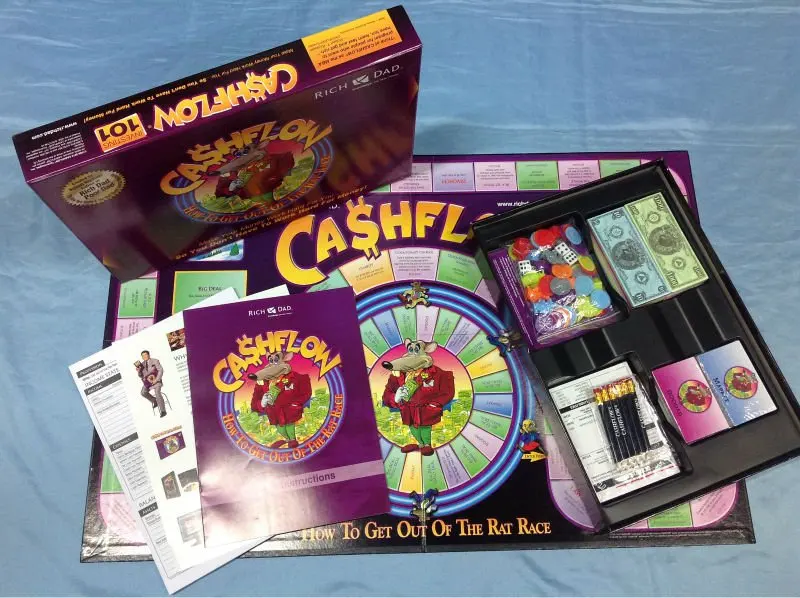Cashflow 101
You've heard about this game called CASHFLOW 101. You like what youheard, and decided you'd like to try it out. You went toRichDad.com, visited the 'Cashflow Circles' forum, and found agroup in your area willing to take in a new player. You're all ready!
Well, almost. You WILL be, after reading this.
Cashflow®ゲームは特許番号5,826,878, 6,032,957および6,106,300 の複数の米国特許により保護されています。 RICH DAD®, Rich Dadのロゴ, CASHFLOW®, CASHFLOW For Kids®, Investing101®, Investing 202®, “How To Get Out Of The Rat Race”®, “Knowledge: The New Money”®, “ESBI” ロゴ, 及び CASHFLOW. Cashflow 101 boardgame may be the most important purchase that you will make in your life. Truly it will change your life and the lives of those that you love. If you only make one purchase for your family this holiday, get this game and play it often! Like Kiyosaki says, 'The more you play the game the richer you become.' We explain the the 6 key factors that affect your Inventory Management efforts, the difference between Inventory Control and Inventory Management, and more. File Archive 973 KB Play Instructions: Install the game - Full Installation. Apply the official Cashflow v1.1.0.1 Patch. Extract the CASHFLOWCRACK.EXE file from the File Archive to the game directory. Execute CASHFLOWCRACK.EXE to play the Game! Cashflow 101 v1.1.0.1 ENGLISH No-CD/Fixed EXE. Cashflow (game series) Cashflow 101. 2019-10-07 14:53:17. Internet Archive HTML5 Uploader 1.6.4. SIMILAR ITEMS (based on metadata).

This Intro will teach you some of the basics of playing thegame. When you play, you will spend less time figuring out what isgoing on, and invest that time into learning to have more money inyour life.
The Steps
Cashflow 101 Pc
The Big Picture
CASHFLOW is played in two parts, and the rules are slightly differentin each.
Everyone starts out in the 'Rat Race'. It mimics how most people livetheir lives financially. The goal of the first part is to get out ofthe Rat Race.
When you do, you go into the second part of the game, called the 'FastTrack'. This is the world the wealthy live in.
The Rat Race and the Fast Track have their own tracks on the gameboard. This intro mainly talks about the Rat Race - you'll learnabout the Fast Track when you get there.
Getting started
You'll receive two playing pieces, a rat and a piece of cheese.
First, pick a dream. These are the pink spaces on the Fast Track.Find one you like, and put your cheese piece on it. For now,all you need to know is that when you get to the fast track,you will have the opportunity to realize your dream. (Some groupsdon't do this step. If your group is like this, take time atsome point to look over the Dream spaces.)
You'll also get a blank game sheet.The game sheet is where you'll record yourfinancial information. It looks similar to this:
This figure has some details left out, as you'll see when youplay the game. For now, there are a few things to notice:
- It has something called an Income Statement. This hastwo sections, labelled 'Income' and 'Expenses'. Eachsection will have several lines, one for each source of income andeach expense.
- It has something called a Balance Sheet, which has two sections,labelled 'Assets' and 'Liabilities'. Each section will have a line for each assetand each liability you have. (You'll learn more about what thosewords mean as you play.)
- The income and expense sections are summarized with 'Total Income'and 'Total Expenses'. The difference between these is 'Monthly Cash Flow'.
- There is something called 'Passive Income', that is a part of yourtotal income.
Next, pick a Profession card (if someone doesn't pick it for you).The profession card looks like a smaller version of the game sheet, withnumbers filled in. You'll copy the info from the Profession Card onto theGame Sheet. After that, you don't need the Profession card.
This is a good time to meet your Auditor. Normally this is the personseated on your right. He or she will check your financial statements(i.e., the income statement and balance sheet)whenever they change. Have them check that you copied the info ontoyour Game Sheet correctly.
The last thing to set up is your starting cash. This is equal to the sum ofyour Savings (in the Asset Column) and one month's cash flow.
This brings us to the next topic - how to keep track of your money.
Keeping Track of Money
As you play the game, you will have income from various sources, andspend money on necessities and investments (both good and bad). There are severalways that you can keep track of how your available cash changes. The methodchosen can make a big difference in how fast the game moves. Here are somemethods players have used, in order of 'slowest' to 'best'.
The first is to use the play money included with the game. It's likeMonopoly money. One player will be the banker, giving out and takingmoney as needed. While using the play money can be fun, it alsoslows things down a LOT.

Another way is to just write down the amount of cash you have.Whenever the amount changes, erase or cross out the number, and writedown the new amount.
A third way is to have a separate sheet of paper, with four columns:'Transaction', '+', '-', and 'Balance'. Whenever something happensthat changes the amount of cash you have, you write down what ishappening in the first column; the change in the second (income) or third(expense) column, depending on whether your cash went up or down; and the newcash amount in the last column. For example, say you pass the'Pay Check' space; you have $2230 in cash, and your monthly cash flow is$840. You write 'Pay' in the first column, '840' in the second, and'3070' (i.e., 2230+840) in the last column. Netdrive 4 crack. The third column isblank. There are times when having a transaction history likethis is very helpful.
A fourth way is to use software that automates all the arithmetic foryou. One that we use and like is cfAccountant, which works on Palmdevices. It makes a lot of things go faster, in fact. (It's shareware;you can download a free trial version atcfAccountant.com.)
Running In The Rat Race

The Rat Race is the track that you start on. Place your rat token on the'Start Here' arrow on this track.
You will find four main kinds of spaces in the Rat Race.
One is the yellow 'Pay Check' space. Whenever you land on or passthis space, add the amount of your Monthly Cash Flow to your total cash.
Another space is the green 'Opportunity' space. This means you have foundan investment opportunity. When you land on this, draw a card fromeither the 'Small Deal' or the 'Big Deal' stack - your choice. ('Small' and 'Big'refers to how much money you will need to partake in the deal. Most Small Dealscost a few thousand or less; Big Deals usually take tens of thousands.)

Next is the blue 'Market' space. When you land on it, draw a Market card.These cards include buyers of investments you may own, such as real estate,and other economic events that may affect you.
The fourth main kind of space is the pink Doodad space. A doodadis something that you spend money on, and which does not really contributeto your financial upliftment. The expense is not optional; when you landon this space, draw a doodad card, read it, and pay up.
There are other spaces too, which I won't go into here.You'll learn about them as you play.
Getting Out
As said before, the goal of part one is to get out of the rat race.
So how do you do that?
When you get your game sheet, you will notice that your income is broken downinto two parts: salary (from your day job), and what is called passive income.Passive income is income that comes in with little or no additional effort on yourpart. If you have royalties from a book, income from a rental property you own,or stock that pays dividends each quarter, you have passive income.
Sometimes you'll have to do SOME work - if that rental house develops aleaky roof, you'd better have it fixed if you want to continue collectingrent! The difference is that for a 'normal' job, you have to invest yourtime continually to keep receiving income, and if you work half as much,your income immediately goes down by half or more. With passive income,after you do some initial work up front, you have an income stream thatcontinues with little or no time on your part to maintain it.
So, again: in this game, how do you get out of the rat race? Very simply,make investments that give you passive income. (Mostly these will come from Small Dealand Big Deal cards.) When your passive income is greater than yourtotal expenses, you are OUT.
Think about what this means. It means you can quit your day job, and maintainthe same standard of living you had before.
When that happens to you, announce it, and high five the people around you :)
A Final Note
There is more to the game than is covered here. Having read this far,you don't know everything there is to know about the game. That isfine, though, because you are over a large part of the learningcurve. The rest will come more easily to you as you play.
Cashflow 101 Directions
Keep in mind that some groups have their own quirks andhouse rules, so if your group does something different than what iswritten above, go along with how they do it. Take it lightly,and have fun.
I would appreciate feedback from people who have used thisintro to prepare for their first game, and from gaming group hostswho refer new people to it. Contact me with any comments atamax@redsymbol.com.
Legal Matters
Cashflow 101 Spanish
Copyright 2003 Aaron Maxwell. This document may be used in wholeor part for any purpose, and in any format. It would benice if you credit the author(Aaron Maxwell), and/orlet him knowhow you are finding it useful, but it's not necessary.
Cashflow 101 Kids
CASHFLOW 101 is a mark of Cashflow Technologies, Inc.The figure in the 'Getting Started' section is a schematiclikeness of the Cashflow 101 game sheet; the game sheet itself is copyright1996, 1997, and 1999 Cashflow Technologies, Inc.